SKODA OCTAVIA 2011 2.G / (1Z) Owner's Manual
Manufacturer: SKODA, Model Year: 2011, Model line: OCTAVIA, Model: SKODA OCTAVIA 2011 2.G / (1Z)Pages: 248, PDF Size: 3.79 MB
Page 171 of 248
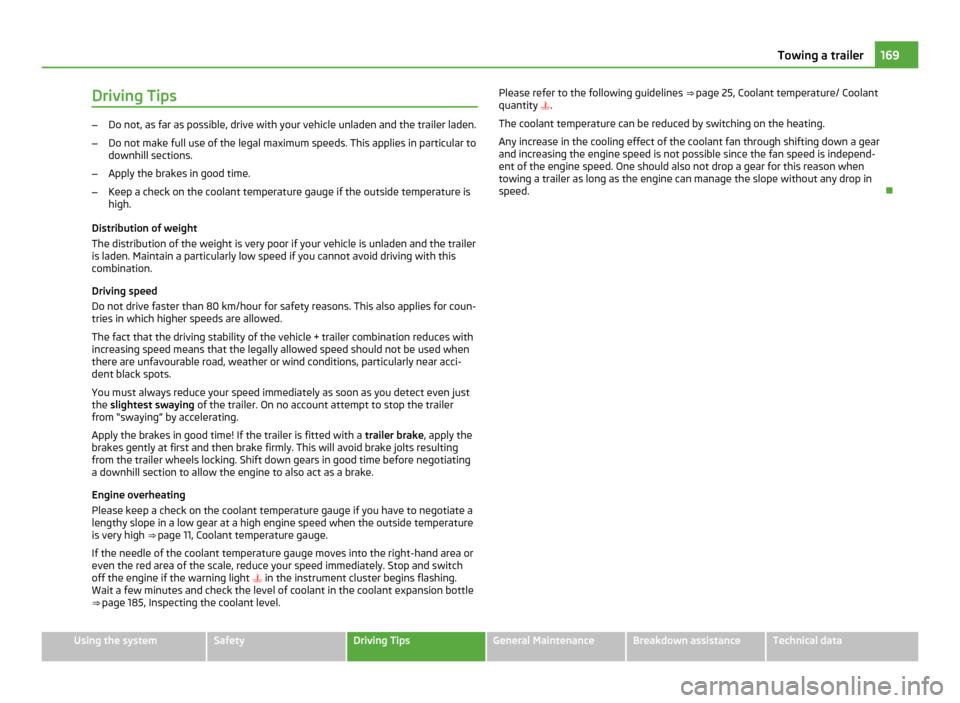
Driving Tips
–
Do not, as far as possible, drive with your vehicle unladen and the trailer laden.
– Do not make full use of the legal maximum speeds. This applies in particular to
downhill sections.
– Apply the brakes in good time.
– Keep a check on the coolant temperature gauge if the outside temperature is
high.
Distribution of weight
The distribution of the weight is very poor if your vehicle is unladen and the trailer
is laden. Maintain a particularly low speed if you cannot avoid driving with this
combination.
Driving speed
Do not drive faster than 80 km/hour for safety reasons. This also applies for coun-
tries in which higher speeds are allowed.
The fact that the driving stability of the vehicle + trailer combination reduces with
increasing speed means that the legally allowed speed should not be used when
there are unfavourable road, weather or wind conditions, particularly near acci-
dent black spots.
You must always reduce your speed immediately as soon as you detect even just
the slightest swaying of the trailer. On no account attempt to stop the trailer
from “swaying”
by accelerating.
Apply the brakes in good time! If the trailer is fitted with a trailer brake, apply the
brakes gently at first and then brake firmly. This will avoid brake jolts resulting
from the trailer wheels locking. Shift down gears in good time before negotiating
a downhill section to allow the engine to also act as a brake.
Engine overheating
Please keep a check on the coolant temperature gauge if you have to negotiate a
lengthy slope in a low gear at a high engine speed when the outside temperature
is very high ⇒ page 11, Coolant temperature gauge.
If the needle of the coolant temperature gauge moves into the right-hand area or
even the red area of the scale, reduce your speed immediately. Stop and switch
off the engine if the warning light in the instrument cluster begins flashing.
Wait a few minutes and check the level of coolant in the coolant expansion bottle
⇒ page 185, Inspecting the coolant level. Please refer to the following guidelines
⇒ page 25, Coolant temperature/ Coolant
quantity .
The coolant temperature can be reduced by switching on the heating.
Any increase in the cooling effect of the coolant fan through shifting down a gear
and increasing the engine speed is not possible since the fan speed is independ-
ent of the engine speed. One should also not drop a gear for this reason when
towing a trailer as long as the engine can manage the slope without any drop in
speed. 169
Towing a trailer Using the system Safety Driving Tips General Maintenance Breakdown assistance Technical data
Page 172 of 248
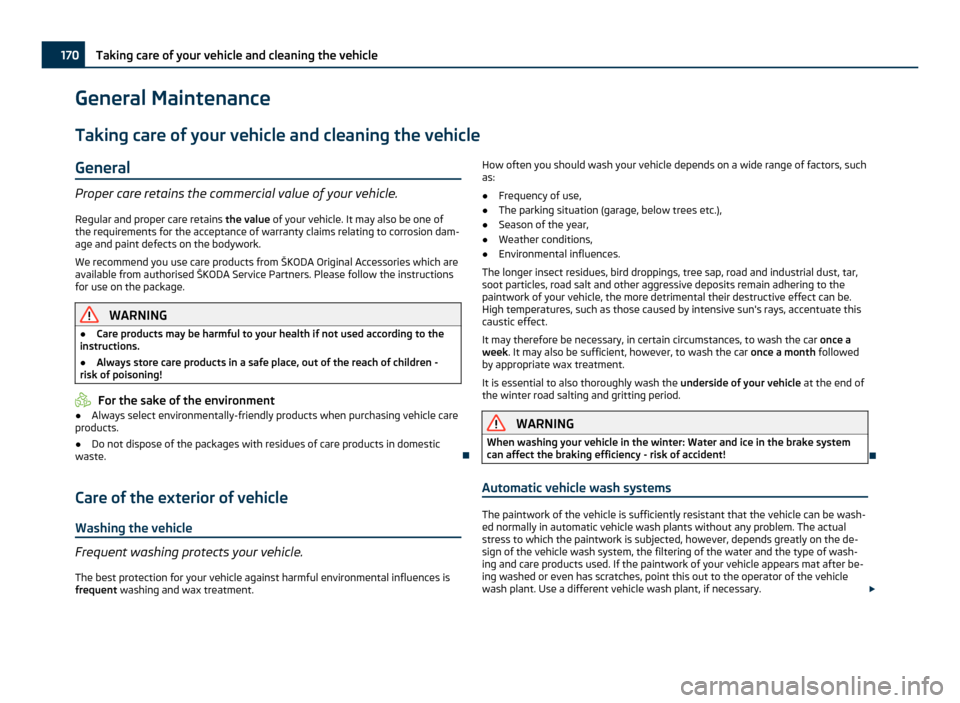
General Maintenance
Taking care of your vehicle and cleaning the vehicle
General Proper care retains the commercial value of your vehicle.
Regular and proper care retains the value of your vehicle. It may also be one of
the requirements for the acceptance of warranty claims relating to corrosion dam-
age and paint defects on the bodywork.
We recommend you use care products from
ŠKODA Original Accessories which are
available from authorised ŠKODA Service Partners. Please follow the instructions
for use on the package. WARNING
● Care products may be harmful to your health if not used according to the
instructions.
● Always store care products in a safe place, out of the reach of children -
risk of poisoning! For the sake of the environment
● Always select environmentally-friendly products when purchasing vehicle care
products.
● Do not dispose of the packages with residues of care products in domestic
waste.
Care of the exterior of vehicle Washing the vehicle Frequent washing protects your vehicle.
The best protection for your vehicle against harmful environmental influences is
frequent washing and wax treatment. How often you should wash your vehicle depends on a wide range of factors, such
as:
● Frequency of use,
● The parking situation (garage, below trees etc.),
● Season of the year,
● Weather conditions,
● Environmental influences.
The longer insect residues, bird droppings, tree sap, road and industrial dust, tar,
soot particles, road salt and other aggressive deposits remain adhering to the
paintwork of your vehicle, the more detrimental their destructive effect can be.
High temperatures, such as those caused by intensive sun's rays, accentuate this
caustic effect.
It may therefore be necessary, in certain circumstances, to wash the car once a
week. It may also be sufficient, however, to wash the car once a month followed
by appropriate wax treatment.
It is essential to also thoroughly wash the underside of your vehicle at the end of
the winter road salting and gritting period. WARNING
When washing your vehicle in the winter: Water and ice in the brake system
can affect the braking efficiency - risk of accident!
Automatic vehicle wash systems The paintwork of the vehicle is sufficiently resistant that the vehicle can be wash-
ed normally in automatic vehicle wash plants without any problem. The actual
stress to which the paintwork is subjected, however, depends greatly on the de-
sign of the vehicle wash system, the filtering of the water and the type of wash-
ing and care products used. If the paintwork of your vehicle appears mat after be-
ing washed or even has scratches, point this out to the operator of the vehicle
wash plant. Use a different vehicle wash plant, if necessary. £170
Taking care of your vehicle and cleaning the vehicle
Page 173 of 248
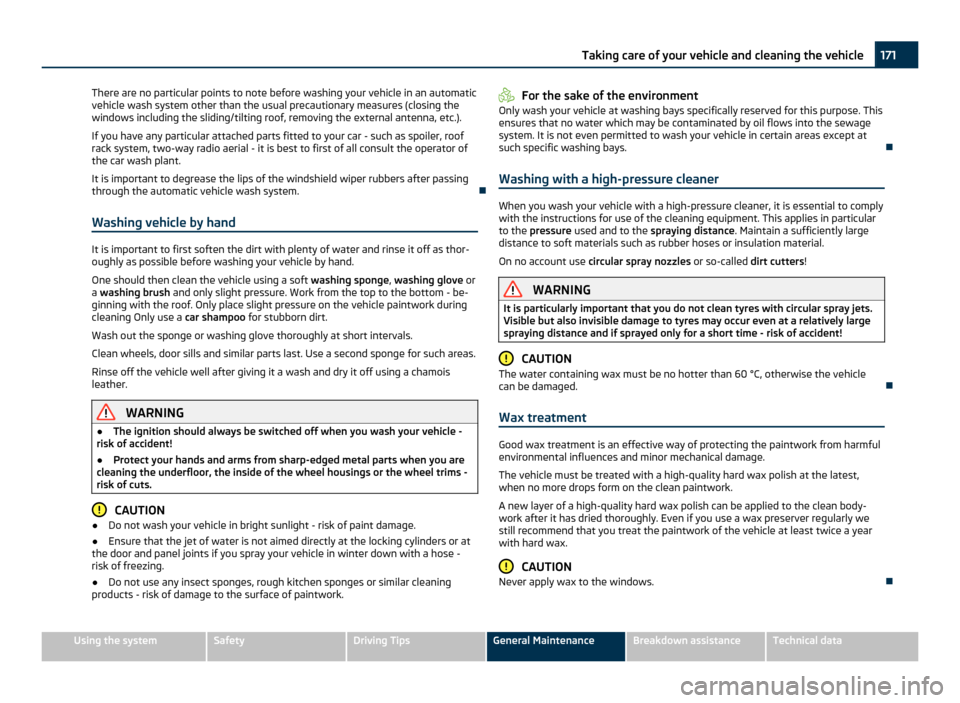
There are no particular points to note before washing your vehicle in an automatic
vehicle wash system other than the usual precautionary measures (closing the
windows including the sliding/tilting roof, removing the external antenna, etc.).
If you have any particular attached parts fitted to your car - such as spoiler, roof
rack system, two-way radio aerial - it is best to first of all consult the operator of
the car wash plant.
It is important to degrease the lips of the windshield wiper rubbers after passing
through the automatic vehicle wash system.
Washing vehicle by hand It is important to first soften the dirt with plenty of water and rinse it off as thor-
oughly as possible before washing your vehicle by hand.
One should then clean the vehicle using a soft
washing sponge, washing glove or
a washing brush and only slight pressure. Work from the top to the bottom - be-
ginning with the roof. Only place slight pressure on the vehicle paintwork during
cleaning Only use a car shampoo for stubborn dirt.
Wash out the sponge or washing glove thoroughly at short intervals.
Clean wheels, door sills and similar parts last. Use a second sponge for such areas.
Rinse off the vehicle well after giving it a wash and dry it off using a chamois
leather. WARNING
● The ignition should always be switched off when you wash your vehicle -
risk of accident!
● Protect your hands and arms from sharp-edged metal parts when you are
cleaning the underfloor, the inside of the wheel housings or the wheel trims -
risk of cuts. CAUTION
● Do not wash your vehicle in bright sunlight - risk of paint damage.
● Ensure that the jet of water is not aimed directly at the locking cylinders or at
the door and panel joints if you spray your vehicle in winter down with a hose -
risk of freezing.
● Do not use any insect sponges, rough kitchen sponges or similar cleaning
products - risk of damage to the surface of paintwork. For the sake of the environment
Only wash your vehicle at washing bays specifically reserved for this purpose. This
ensures that no water which may be contaminated by oil flows into the sewage
system. It is not even permitted to wash your vehicle in certain areas except at
such specific washing bays.
Washing with a high-pressure cleaner When you wash your vehicle with a high-pressure cleaner, it is essential to comply
with the instructions for use of the cleaning equipment. This applies in particular
to the pressure
used and to the spraying distance. Maintain a sufficiently large
distance to soft materials such as rubber hoses or insulation material.
On no account use circular spray nozzles or so-called dirt cutters! WARNING
It is particularly important that you do not clean tyres with circular spray jets.
Visible but also invisible damage to tyres may occur even at a relatively large
spraying distance and if sprayed only for a short time - risk of accident! CAUTION
The water containing wax must be no hotter than 60 °C, otherwise the vehicle
can be damaged.
Wax treatment Good wax treatment is an effective way of protecting the paintwork from harmful
environmental influences and minor mechanical damage.
The vehicle must be treated with a high-quality hard wax polish at the latest,
when no more drops form on the clean paintwork.
A new layer of a high-quality hard wax polish can be applied to the clean body-
work after it has dried thoroughly. Even if you use a wax preserver regularly we
still recommend that you treat the paintwork of the vehicle at least twice a year
with hard wax. CAUTION
Never apply wax to the windows. 171
Taking care of your vehicle and cleaning the vehicle Using the system Safety Driving Tips General Maintenance Breakdown assistance Technical data
Page 174 of 248
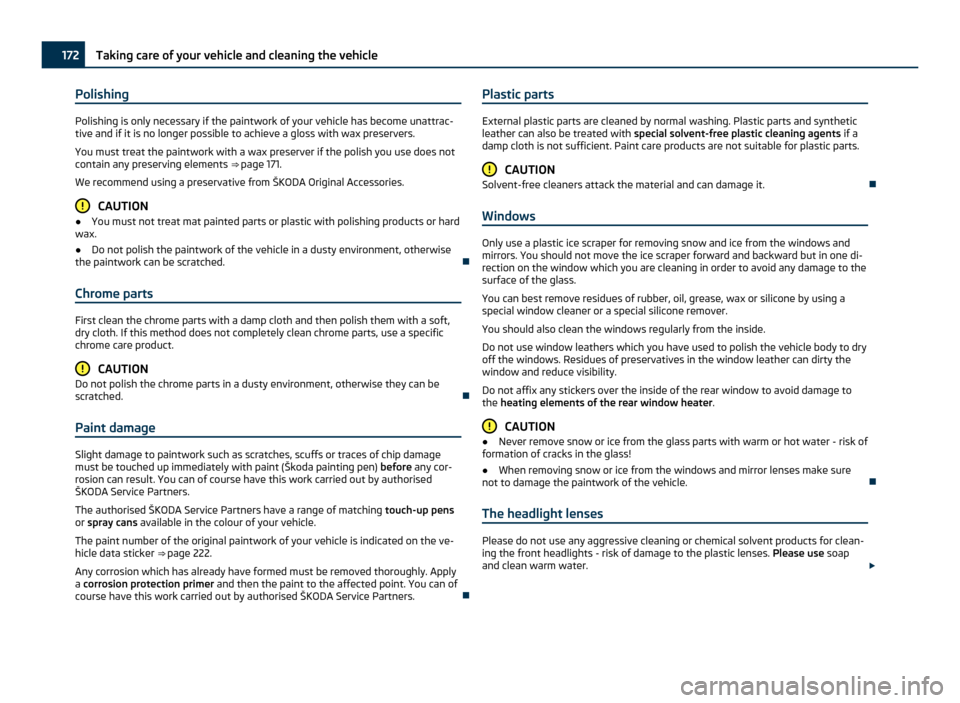
Polishing
Polishing is only necessary if the paintwork of your vehicle has become unattrac-
tive and if it is no longer possible to achieve a gloss with wax preservers.
You must treat the paintwork with a wax preserver if the polish you use does not
contain any preserving elements ⇒ page 171.
We recommend using a preservative from
ŠKODA Original Accessories.CAUTION
● You must not treat mat painted parts or plastic with polishing products or hard
wax.
● Do not polish the paintwork of the vehicle in a dusty environment, otherwise
the paintwork can be scratched.
Chrome parts First clean the chrome parts with a damp cloth and then polish them with a soft,
dry cloth. If this method does not completely clean chrome parts, use a specific
chrome care product.
CAUTION
Do not polish the chrome parts in a dusty environment, otherwise they can be
scratched.
Paint damage Slight damage to paintwork such as scratches, scuffs or traces of chip damage
must be touched up immediately with paint (Škoda painting pen)
before any cor-
rosion can result. You can of course have this work carried out by authorised
ŠKODA Service Partners.
The authorised
ŠKODA Service Partners have a range of matching touch-up pens
or spray cans available in the colour of your vehicle.
The paint number of the original paintwork of your vehicle is indicated on the ve-
hicle data sticker ⇒ page 222.
Any corrosion which has already have formed must be removed thoroughly. Apply
a corrosion protection primer and then the paint to the affected point. You can of
course have this work carried out by authorised ŠKODA Service Partners. Plastic parts External plastic parts are cleaned by normal washing. Plastic parts and synthetic
leather can also be treated with special solvent-free plastic cleaning agents if a
damp cloth is not sufficient. Paint care products are not suitable for plastic parts. CAUTION
Solvent-free cleaners attack the material and can damage it.
Windows Only use a plastic ice scraper for removing snow and ice from the windows and
mirrors. You should not move the ice scraper forward and backward but in one di-
rection on the window which you are cleaning in order to avoid any damage to the
surface of the glass.
You can best remove residues of rubber, oil, grease, wax or silicone by using a
special window cleaner or a special silicone remover.
You should also clean the windows regularly from the inside.
Do not use window leathers which you have used to polish the vehicle body to dry
off the windows. Residues of preservatives in the window leather can dirty the
window and reduce visibility.
Do not affix any stickers over the inside of the rear window to avoid damage to
the heating elements of the rear window heater . CAUTION
● Never remove snow or ice from the glass parts with warm or hot water - risk of
formation of cracks in the glass!
● When removing snow or ice from the windows and mirror lenses make sure
not to damage the paintwork of the vehicle.
The headlight lenses Please do not use any aggressive cleaning or chemical solvent products for clean-
ing the front headlights - risk of damage to the plastic lenses.
Please use soap
and clean warm water. £172
Taking care of your vehicle and cleaning the vehicle
Page 175 of 248
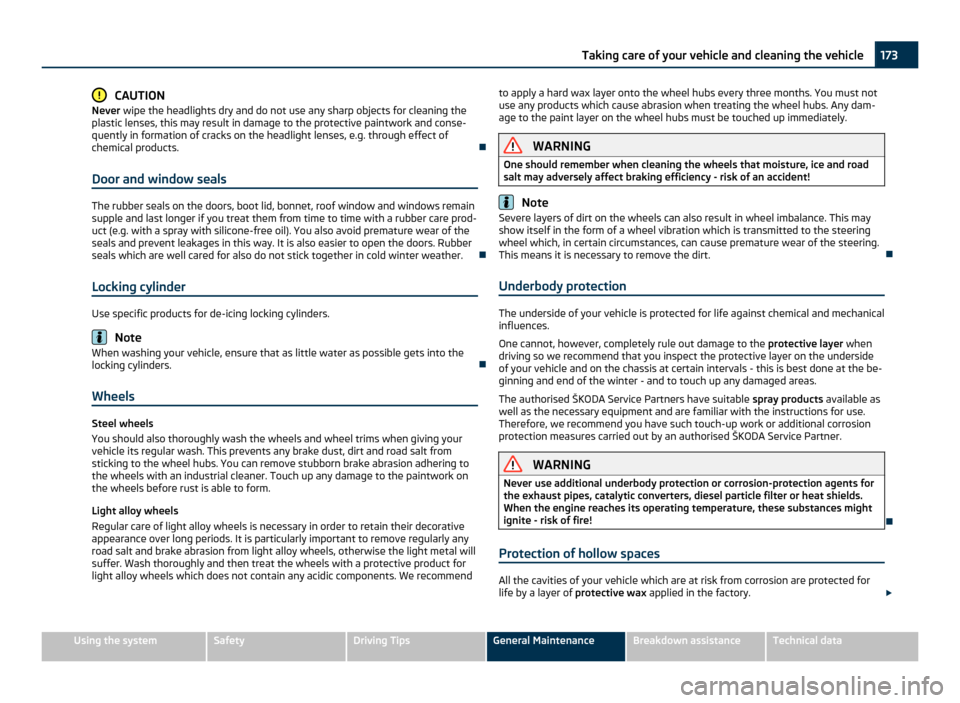
CAUTION
Never wipe the headlights dry and do not use any sharp objects for cleaning the
plastic lenses, this may result in damage to the protective paintwork and conse-
quently in formation of cracks on the headlight lenses, e.g. through effect of
chemical products.
Door and window seals The rubber seals on the doors, boot lid, bonnet, roof window and windows remain
supple and last longer if you treat them from time to time with a rubber care prod-
uct (e.g. with a spray with silicone-free oil). You also avoid premature wear of the
seals and prevent leakages in this way. It is also easier to open the doors. Rubber
seals which are well cared for also do not stick together in cold winter weather.
Locking cylinder Use specific products for de-icing locking cylinders.
Note
When washing your vehicle, ensure that as little water as possible gets into the
locking cylinders.
Wheels Steel wheels
You should also thoroughly wash the wheels and wheel trims when giving your
vehicle its regular wash. This prevents any brake dust, dirt and road salt from
sticking to the wheel hubs. You can remove stubborn brake abrasion adhering to
the wheels with an industrial cleaner. Touch up any damage to the paintwork on
the wheels before rust is able to form.
Light alloy wheels
Regular care of light alloy wheels is necessary in order to retain their decorative
appearance over long periods. It is particularly important to remove regularly any
road salt and brake abrasion from light alloy wheels, otherwise the light metal will
suffer. Wash thoroughly and then treat the wheels with a protective product for
light alloy wheels which does not contain any acidic components. We recommend to apply a hard wax layer onto the wheel hubs every three months. You must not
use any products which cause abrasion when treating the wheel hubs. Any dam-
age to the paint layer on the wheel hubs must be touched up immediately. WARNING
One should remember when cleaning the wheels that moisture, ice and road
salt may adversely affect braking efficiency - risk of an accident! Note
Severe layers of dirt on the wheels can also result in wheel imbalance. This may
show itself in the form of a wheel vibration which is transmitted to the steering
wheel which, in certain circumstances, can cause premature wear of the steering.
This means it is necessary to remove the dirt.
Underbody protection The underside of your vehicle is protected for life against chemical and mechanical
influences.
One cannot, however, completely rule out damage to the protective layer
when
driving so we recommend that you inspect the protective layer on the underside
of your vehicle and on the chassis at certain intervals - this is best done at the be-
ginning and end of the winter - and to touch up any damaged areas.
The authorised ŠKODA Service Partners have suitable spray products available as
well as the necessary equipment and are familiar with the instructions for use.
Therefore, we recommend you have such touch-up work or additional corrosion
protection measures carried out by an authorised ŠKODA Service Partner. WARNING
Never use additional underbody protection or corrosion-protection agents for
the exhaust pipes, catalytic converters, diesel particle filter or heat shields.
When the engine reaches its operating temperature, these substances might
ignite - risk of fire!
Protection of hollow spaces All the cavities of your vehicle which are at risk from corrosion are protected for
life by a layer of protective wax applied in the factory. £ 173
Taking care of your vehicle and cleaning the vehicle Using the system Safety Driving Tips General Maintenance Breakdown assistance Technical data
Page 176 of 248
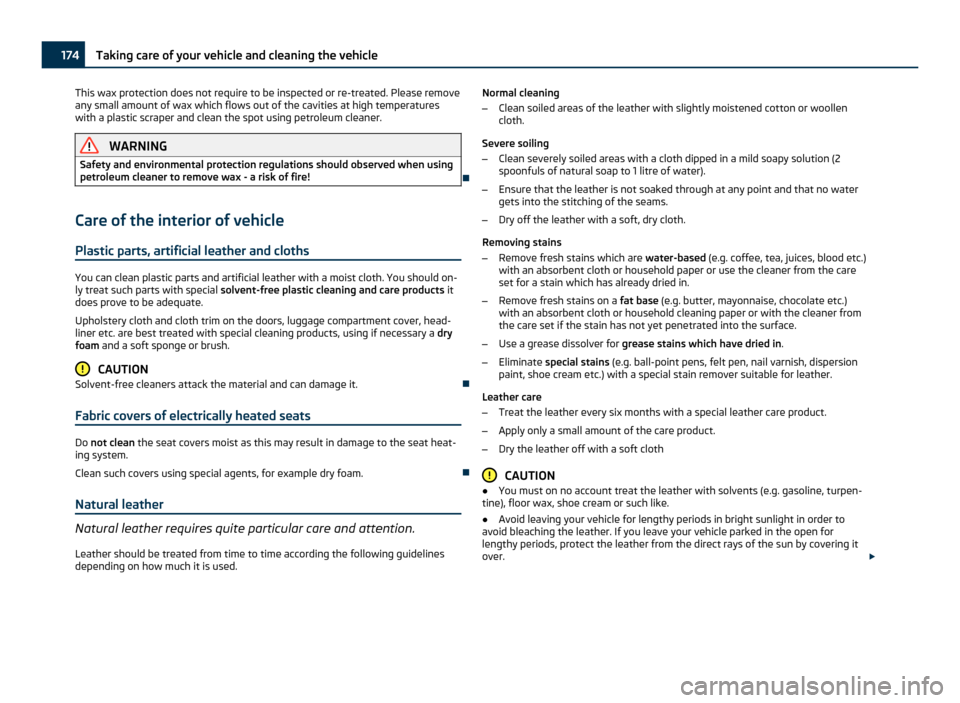
This wax protection does not require to be inspected or re-treated. Please remove
any small amount of wax which flows out of the cavities at high temperatures
with a plastic scraper and clean the spot using petroleum cleaner.
WARNING
Safety and environmental protection regulations should observed when using
petroleum cleaner to remove wax - a risk of fire!
Care of the interior of vehicle Plastic parts, artificial leather and cloths You can clean plastic parts and artificial leather with a moist cloth. You should on-
ly treat such parts with special solvent-free plastic cleaning and care products it
does prove to be adequate.
Upholstery cloth and cloth trim on the doors, luggage compartment cover, head-
liner etc. are best treated with special cleaning products, using if necessary a dry
foam and a soft sponge or brush. CAUTION
Solvent-free cleaners attack the material and can damage it.
Fabric covers of electrically heated seats Do not clean
the seat covers moist as this may result in damage to the seat heat-
ing system.
Clean such covers using special agents, for example dry foam.
Natural leather Natural leather requires quite particular care and attention.
Leather should be treated from time to time according the following guidelines
depending on how much it is used. Normal cleaning
–
Clean soiled areas of the leather with slightly moistened cotton or woollen
cloth.
Severe soiling
– Clean severely soiled areas with a cloth dipped in a mild soapy solution (2
spoonfuls of natural soap to 1 litre of water).
– Ensure that the leather is not soaked through at any point and that no water
gets into the stitching of the seams.
– Dry off the leather with a soft, dry cloth.
Removing stains
– Remove fresh stains which are water-based (e.g. coffee, tea, juices, blood etc.)
with an absorbent cloth or household paper or use the cleaner from the care
set for a stain which has already dried in.
– Remove fresh stains on a fat base (e.g. butter, mayonnaise, chocolate etc.)
with an absorbent cloth or household cleaning paper or with the cleaner from
the care set if the stain has not yet penetrated into the surface.
– Use a grease dissolver for grease stains which have dried in .
– Eliminate special stains (e.g. ball-point pens, felt pen, nail varnish, dispersion
paint, shoe cream etc.) with a special stain remover suitable for leather.
Leather care
– Treat the leather every six months with a special leather care product.
– Apply only a small amount of the care product.
– Dry the leather off with a soft cloth CAUTION
● You must on no account treat the leather with solvents (e.g. gasoline, turpen-
tine), floor wax, shoe cream or such like.
● Avoid leaving your vehicle for lengthy periods in bright sunlight in order to
avoid bleaching the leather. If you leave your vehicle parked in the open for
lengthy periods, protect the leather from the direct rays of the sun by covering it
over. £174
Taking care of your vehicle and cleaning the vehicle
Page 177 of 248
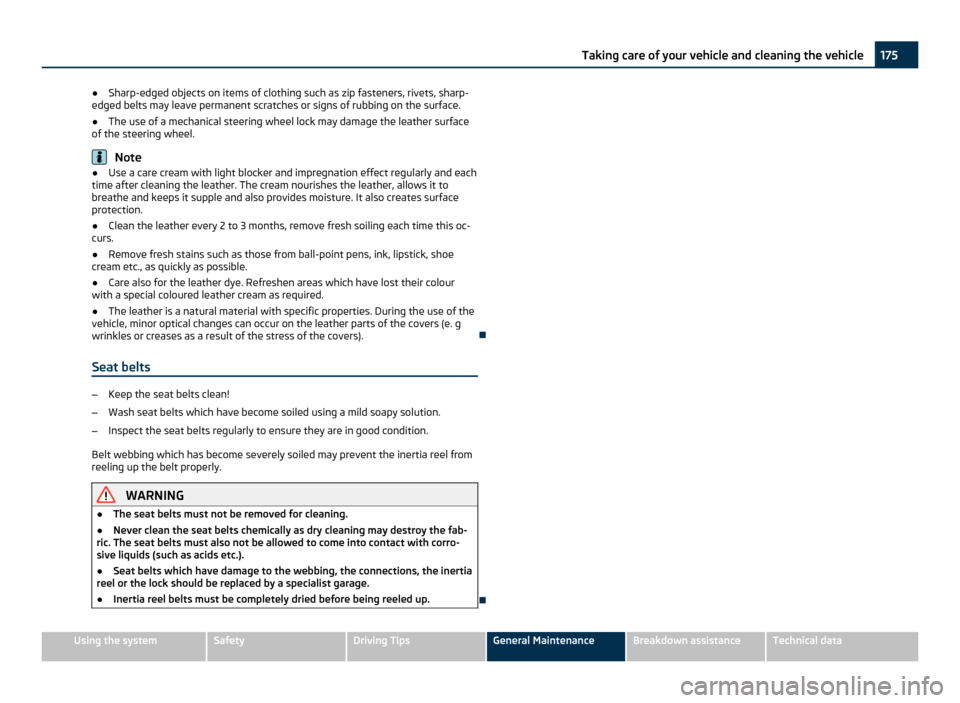
●
Sharp-edged objects on items of clothing such as zip fasteners, rivets, sharp-
edged belts may leave permanent scratches or signs of rubbing on the surface.
● The use of a mechanical steering wheel lock may damage the leather surface
of the steering wheel. Note
● Use a care cream with light blocker and impregnation effect regularly and each
time after cleaning the leather. The cream nourishes the leather, allows it to
breathe and keeps it supple and also provides moisture. It also creates surface
protection.
● Clean the leather every 2 to 3 months, remove fresh soiling each time this oc-
curs.
● Remove fresh stains such as those from ball-point pens, ink, lipstick, shoe
cream etc., as quickly as possible.
● Care also for the leather dye. Refreshen areas which have lost their colour
with a special coloured leather cream as required.
● The leather is a natural material with specific properties. During the use of the
vehicle, minor optical changes can occur on the leather parts of the covers (e. g
wrinkles or creases as a result of the stress of the covers).
Seat belts –
Keep the seat belts clean!
– Wash seat belts which have become soiled using a mild soapy solution.
– Inspect the seat belts regularly to ensure they are in good condition.
Belt webbing which has become severely soiled may prevent the inertia reel from
reeling up the belt properly. WARNING
● The seat belts must not be removed for cleaning.
● Never clean the seat belts chemically as dry cleaning may destroy the fab-
ric. The seat belts must also not be allowed to come into contact with corro-
sive liquids (such as acids etc.).
● Seat belts which have damage to the webbing, the connections, the inertia
reel or the lock should be replaced by a specialist garage.
● Inertia reel belts must be completely dried before being reeled up. 175
Taking care of your vehicle and cleaning the vehicle Using the system Safety Driving Tips General Maintenance Breakdown assistance Technical data
Page 178 of 248
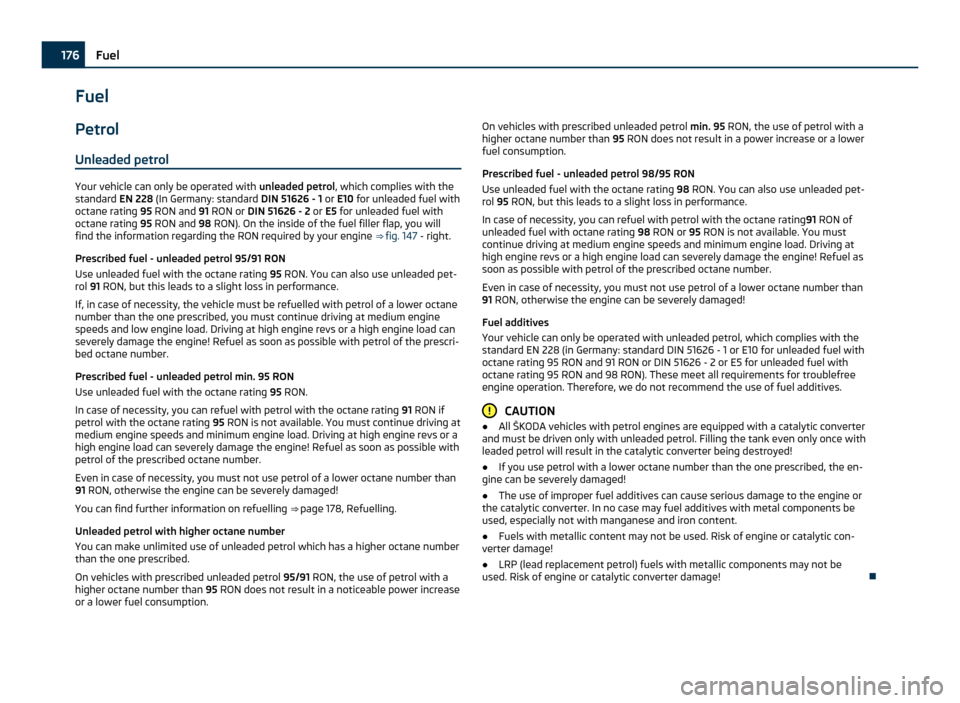
Fuel
Petrol
Unleaded petrol Your vehicle can only be operated with
unleaded petrol, which complies with the
standard EN 228 (In Germany: standard DIN 51626 - 1 or E10 for unleaded fuel with
octane rating 95 RON and 91 RON or DIN 51626 - 2 or E5 for unleaded fuel with
octane rating 95 RON and 98 RON). On the inside of the fuel filler flap, you will
find the information regarding the RON required by your engine ⇒
fig. 147 - right.
Prescribed fuel - unleaded petrol 95/91 RON
Use unleaded fuel with the octane rating 95 RON. You can also use unleaded pet-
rol 91 RON, but this leads to a slight loss in performance.
If, in case of necessity, the vehicle must be refuelled with petrol of a lower octane
number than the one prescribed, you must continue driving at medium engine
speeds and low engine load. Driving at high engine revs or a high engine load can
severely damage the engine! Refuel as soon as possible with petrol of the prescri-
bed octane number.
Prescribed fuel - unleaded petrol min. 95 RON
Use unleaded fuel with the octane rating 95 RON.
In case of necessity, you can refuel with petrol with the octane rating 91 RON if
petrol with the octane rating 95 RON is not available. You must continue driving at
medium engine speeds and minimum engine load. Driving at high engine revs or a
high engine load can severely damage the engine! Refuel as soon as possible with
petrol of the prescribed octane number.
Even in case of necessity, you must not use petrol of a lower octane number than
91 RON, otherwise the engine can be severely damaged!
You can find further information on refuelling ⇒ page 178, Refuelling.
Unleaded petrol with higher octane number
You can make unlimited use of unleaded petrol which has a higher octane number
than the one prescribed.
On vehicles with prescribed unleaded petrol 95/91 RON, the use of petrol with a
higher octane number than 95 RON does not result in a noticeable power increase
or a lower fuel consumption. On vehicles with prescribed unleaded petrol
min. 95 RON, the use of petrol with a
higher octane number than 95 RON does not result in a power increase or a lower
fuel consumption.
Prescribed fuel - unleaded petrol 98/95 RON
Use unleaded fuel with the octane rating 98 RON. You can also use unleaded pet-
rol 95 RON, but this leads to a slight loss in performance.
In case of necessity, you can refuel with petrol with the octane rating 91 RON of
unleaded fuel with octane rating 98
RON or 95 RON is not available. You must
continue driving at medium engine speeds and minimum engine load. Driving at
high engine revs or a high engine load can severely damage the engine! Refuel as
soon as possible with petrol of the prescribed octane number.
Even in case of necessity, you must not use petrol of a lower octane number than
91 RON, otherwise the engine can be severely damaged!
Fuel additives
Your vehicle can only be operated with unleaded petrol, which complies with the
standard EN 228 (in Germany: standard DIN 51626 - 1 or E10 for unleaded fuel with
octane rating 95 RON and 91 RON or DIN 51626 - 2 or E5 for unleaded fuel with
octane rating 95 RON and 98 RON). These meet all requirements for troublefree
engine operation. Therefore, we do not recommend the use of fuel additives. CAUTION
● All
ŠKODA vehicles with petrol engines are equipped with a catalytic converter
and must be driven only with unleaded petrol. Filling the tank even only once with
leaded petrol will result in the catalytic converter being destroyed!
● If you use petrol with a lower octane number than the one prescribed, the en-
gine can be severely damaged!
● The use of improper fuel additives can cause serious damage to the engine or
the catalytic converter. In no case may fuel additives with metal components be
used, especially not with manganese and iron content.
● Fuels with metallic content may not be used. Risk of engine or catalytic con-
verter damage!
● LRP (lead replacement petrol) fuels with metallic components may not be
used. Risk of engine or catalytic converter damage! 176
Fuel
Page 179 of 248
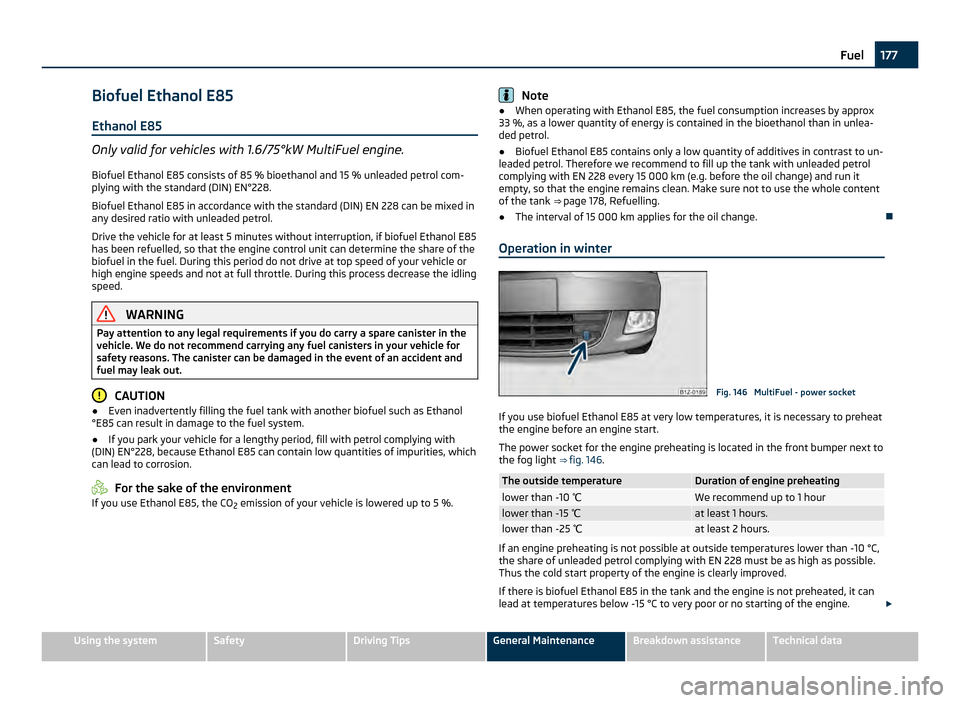
Biofuel Ethanol E85
Ethanol E85 Only valid for vehicles with 1.6/75°kW MultiFuel engine.
Biofuel Ethanol E85 consists of 85 % bioethanol and 15 % unleaded petrol com-
plying with the standard (DIN) EN°228.
Biofuel Ethanol E85 in accordance with the standard (DIN) EN 228 can be mixed in
any desired ratio with unleaded petrol.
Drive the vehicle for at least 5 minutes without interruption, if biofuel Ethanol E85
has been refuelled, so that the engine control unit can determine the share of the
biofuel in the fuel. During this period do not drive at top speed of your vehicle or
high engine speeds and not at full throttle. During this process decrease the idling
speed. WARNING
Pay attention to any legal requirements if you do carry a spare canister in the
vehicle. We do not recommend carrying any fuel canisters in your vehicle for
safety reasons. The canister can be damaged in the event of an accident and
fuel may leak out. CAUTION
● Even inadvertently filling the fuel tank with another biofuel such as Ethanol
°E85 can result in damage to the fuel system.
● If you park your vehicle for a lengthy period, fill with petrol complying with
(DIN) EN°228, because Ethanol E85 can contain low quantities of impurities, which
can lead to corrosion. For the sake of the environment
If you use Ethanol E85, the CO 2 emission of your vehicle is lowered up to 5 %. Note
● When operating with Ethanol E85, the fuel consumption increases by approx
33 %, as a lower quantity of energy is contained in the bioethanol than in unlea-
ded petrol.
● Biofuel Ethanol E85 contains only a low quantity of additives in contrast to un-
leaded petrol. Therefore we recommend to fill up the tank with unleaded petrol
complying with EN 228 every 15 000 km (e.g. before the oil change) and run it
empty, so that the engine remains clean. Make sure not to use the whole content
of the tank ⇒ page 178, Refuelling
.
● The interval of 15 000 km applies for the oil change.
Operation in winter Fig. 146 MultiFuel - power socket
If you use biofuel Ethanol E85 at very low temperatures, it is necessary to preheat
the engine before an engine start.
The power socket for the engine preheating is located in the front bumper next to
the fog light ⇒
fig. 146 . The outside temperature Duration of engine preheating
lower than -10
℃ We recommend up to 1 hour
lower than -15
℃ at least 1 hours.
lower than -25
℃ at least 2 hours.
If an engine preheating is not possible at outside temperatures lower than -10 °C,
the share of unleaded petrol complying with EN 228 must be as high as possible.
Thus the cold start property of the engine is clearly improved.
If there is biofuel Ethanol E85 in the tank and the engine is not preheated, it can
lead at temperatures below -15 °C to very poor or no starting of the engine. £ 177
Fuel Using the system Safety Driving Tips General Maintenance Breakdown assistance Technical data
Page 180 of 248
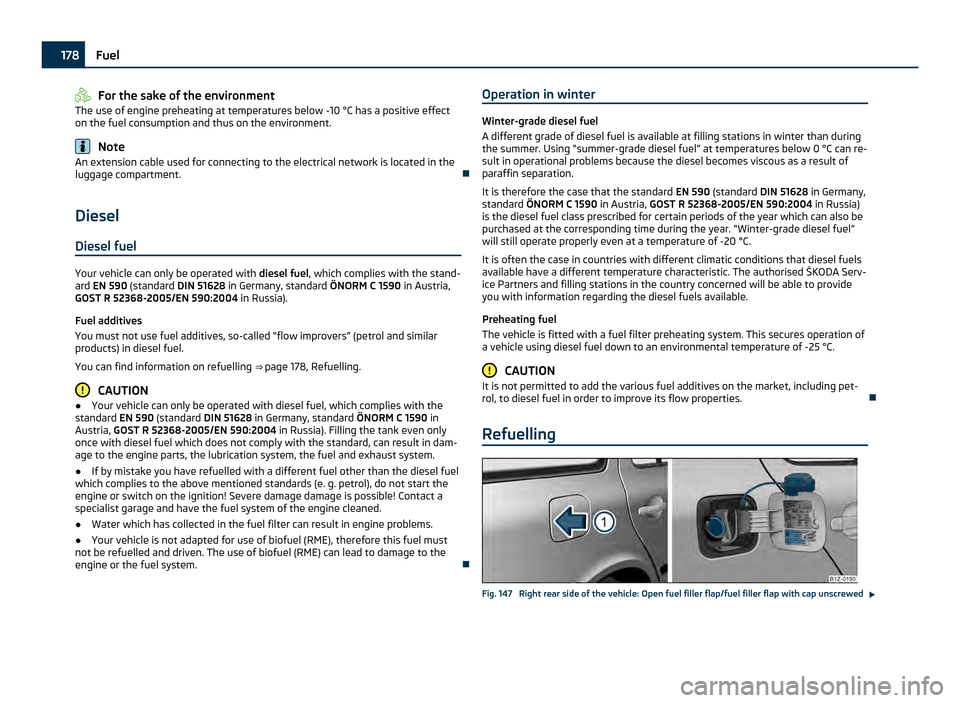
For the sake of the environment
The use of engine preheating at temperatures below -10 °C has a positive effect
on the fuel consumption and thus on the environment. Note
An extension cable used for connecting to the electrical network is located in the
luggage compartment.
Diesel Diesel fuel Your vehicle can only be operated with
diesel fuel, which complies with the stand-
ard EN 590 (standard DIN 51628 in Germany, standard ÖNORM
C 1590 in Austria,
GOST R 52368-2005/EN 590:2004 in Russia).
Fuel additives
You must not use fuel additives, so-called “flow improvers” (petrol and similar
products) in diesel fuel.
You can find information on refuelling ⇒ page 178, Refuelling. CAUTION
● Your vehicle can only be operated with diesel fuel, which complies with the
standard EN 590 (standard DIN 51628 in Germany, standard ÖNORM
C 1590 in
Austria, GOST R 52368-2005/EN 590:2004 in Russia). Filling the tank even only
once with diesel fuel which does not comply with the standard, can result in dam-
age to the engine parts, the lubrication system, the fuel and exhaust system.
● If by mistake you have refuelled with a different fuel other than the diesel fuel
which complies to the above mentioned standards (e.
g. petrol), do not start the
engine or switch on the ignition! Severe damage damage is possible! Contact a
specialist garage and have the fuel system of the engine cleaned.
● Water which has collected in the fuel filter can result in engine problems.
● Your vehicle is not adapted for use of biofuel (RME), therefore this fuel must
not be refuelled and driven. The use of biofuel (RME) can lead to damage to the
engine or the fuel system. Operation in winter Winter-grade diesel fuel
A different grade of diesel fuel is available at filling stations in winter than during
the summer. Using
“summer-grade diesel fuel” at temperatures below 0 °C can re-
sult in operational problems because the diesel becomes viscous as a result of
paraffin separation.
It is therefore the case that the standard EN 590 (standard DIN 51628 in Germany,
standard ÖNORM C 1590 in Austria, GOST R 52368-2005/EN 590:2004 in Russia)
is the diesel fuel class prescribed for certain periods of the year which can also be
purchased at the corresponding time during the year. “Winter-grade diesel fuel”
will still operate properly even at a temperature of -20 °C.
It is often the case in countries with different climatic conditions that diesel fuels
available have a different temperature characteristic. The authorised ŠKODA Serv-
ice Partners and filling stations in the country concerned will be able to provide
you with information regarding the diesel fuels available.
Preheating fuel
The vehicle is fitted with a fuel filter preheating system. This secures operation of
a vehicle using diesel fuel down to an environmental temperature of -25 °C. CAUTION
It is not permitted to add the various fuel additives on the market, including pet-
rol, to diesel fuel in order to improve its flow properties.
Refuelling Fig. 147 Right rear side of the vehicle: Open fuel filler flap/fuel filler flap with cap unscrewed
£178
Fuel